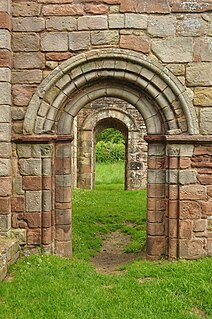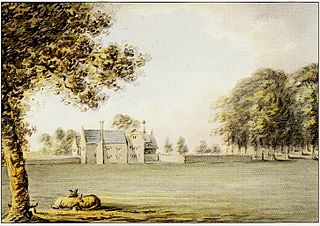Related Research Articles

White Ladies Priory, once the Priory of St Leonard at Brewood, was an English priory of Augustinian canonesses, now in ruins, in Shropshire, in the parish of Boscobel, some eight miles (13 km) northwest of Wolverhampton, near Junction 3 of the M54 motorway. Dissolved in 1536, it became famous for its role in the escape of Charles II of England after the Battle of Worcester in 1651. The name 'White Ladies' refers to the canonesses who lived there and who wore white religious habits.

White Ladies Aston is a village in the Wychavon local government district of Worcestershire, England, United Kingdom, and also lends its name to the Civil Parish in which the village is located. The village is located to the east of the A44 which started as a Saltway linking Droitwich to Oxford. To the south is Pershore and five miles west is Worcester. The parish is bound to the east by the Bow Brook. The parish, according to the 2011 census, has 87 households with 220 residents.
Westwood Priory was a priory of Benedictine nuns founded in 1153, near Droitwich, Worcestershire, England. It was a daughter house of Fontevraud Abbey, seized by the English crown in 1537 during the Dissolution of the monasteries.

Gloucester Abbey was a Benedictine abbey in the city of Gloucester, England. Since 1541 it has been Gloucester Cathedral.

Carisbrooke Priory was an alien priory, a dependency of Lyre Abbey in Normandy. This was dissolved in around 1415. priory was situated on rising ground on the outskirts of Carisbrooke close to Newport on the Isle of Wight. A second Carisbrooke Priory was created in 1993, when St. Dominic's Priory, which had been established as a community of Dominican nuns in 1865–66 was so renamed.

Cowick is a suburb of the City of Exeter in Devon. Historically it was a manor situated in the parish of St Thomas, Exeter, within the hundred of Wonford. It was formerly the site of a Benedictine monastery.
Harrold Priory was a priory in Harrold, Bedfordshire, England. It was established in 1138 and disestablished in 1536.

Markyate Priory was a Benedictine priory in Bedfordshire, England. It was established in 1145 and disestablished in 1537.
Poughley Priory was a priory of Austin Canons at Chaddleworth in the English county of Berkshire, located between Great Shefford and Leckhampstead.

King's Mead Priory was a Benedictine Priory situated west of Derby, in the area currently known as Nun's Street, or Nun's Green. It was the only Benedictine Nunnery in Derbyshire.

Pamber Priory is a Church of England parish church and former priory, then known as West Sherborne Priory or Monk Sherborne Priory, at Monk Sherborne in the English county of Hampshire.

Bullington Priory was a priory in Bullington, Lincolnshire, England.

Sempringham Priory was a priory in Lincolnshire, England, located in the medieval hamlet of Sempringham, to the northwest of Pointon. Today, all that remains of the priory is a marking on the ground where the walls stood and a square, which are identifiable only in aerial photos of the vicinity. However, the parish church of St Andrew's, built around 1100 AD, is witness to the priory standing alone in a field away from the main road.

Farewell Priory was a Benedictine nunnery near Lichfield in Staffordshire, England. Although it received considerable episcopal support, it was always small and poor. It was dissolved in 1527 as a by-product of Cardinal Wolsey's scheme to establish a college within Oxford University.
Campsey Priory,, was a religious house of Augustinian canonesses at Campsea Ashe, Suffolk, about 1.5 miles (2.5 km) south east of Wickham Market. It was founded shortly before 1195 on behalf of two of his sisters by Theobald de Valoines, who, with his wife Avice, had previously founded Hickling Priory in Norfolk for male canons in 1185. Both houses were suppressed in 1536.
Cookhill Priory was a Cistercian nunnery near Cookhill in Worcestershire, England.

Black Ladies Priory was a house of Benedictine nuns, located about 4 km west of Brewood in Staffordshire, on the northern edge of the hamlet of Kiddemore Green. Founded in the mid-12th century, it was a small, often struggling, house. It was dissolved in 1538, and a large house was built on the site in Tudor and Jacobean styles by the Giffard family of Chillington Hall. Much of this is incorporated in the present Black Ladies, a large, Grade II*-listed, private residence.
Thelsford Priory is a site listed by the Historic Buildings and Monuments Commission for England.

Morville Priory was a small Benedictine monastery in Shropshire, England, a cell of Shrewsbury Abbey.

St John the Baptist is a church in White Ladies Aston, Worcestershire, England. It has been designated as a Grade II* listed building by Historic England.
References
- ↑ The Victoria history of the county of Worcester. Willis Bund, J. W. (John William), 1843-1928., Doubleday, H. Arthur (Herbert Arthur), 1867-1941., Page, William, 1861-1934. Folkestone, Eng.: Published for the University of London, Institute of Historical Research by Dawsons of Pall Mall. 1971. ISBN 0-7129-0479-4. OCLC 49694121.
{{cite book}}: CS1 maint: others (link)
Coordinates: 52°42′08″N2°53′22″W / 52.702331°N 2.889375°W
